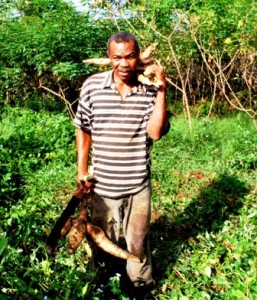In the 1970s the cassava mealybug first threatened to decimate cassava crops throughout sub-Saharan Africa, causing fear of widespread famine. Although cassava (a perennial woody shrub with an edible root) originates from South America, it has been a staple crop in Africa since colonial governments first introduced it to local farmers. Some 300 years later, this hardy crop, which is useful from the leaves to the roots and requires little inputs such as fertilizer, has become a vital source of calories and income for millions of Africans. By the 1980s, the cassava mealybug threatened to wipe out cassava in Africa, which posed a major threat to food security in the region.

In response, the International Institute for Tropical Agriculture (IITA), a nonprofit organization founded in 1967, established an Africa-wide Biological Control Center in Nigeria. The IITA, headquartered in Ibadon, Nigeria, also organized a network of international collaborators and sent a group of scientists to Central and South America in search of the pest’s natural enemy. Once they found it–a parasitic wasp (Epidinocarsis Lopezi)–and introduced it into mealybug infested areas under strict controls, the wasp destroyed the mealybug populations, allowing farmers to rehabilitate their crops.
IITA’s scientists were able to reduce the damage caused by cassava mealybug by 95 percent and farmers across sub-Saharan Africa have come to rely upon the Institute’s research and innovations. With programs dedicated to all major crops produced in the region, including bananas, plantains, cereals, legumes, roots and tubers, economist, social scientists, plant pathologists, horticulturalists and agronomists working for the Institute, are dedicated to finding solutions to hunger and malnutrition in sub-Saharan Africa.
Although many campaigns against food insecurity tend to be reactive, demanding a call to action after a new plant disease or pest emerges, food prices spike, or drought conditions develop, according to Mr. Peter Asiedu, director of the IITA, it doesn’t always have to be this way. IITA’s primary role is to help farmers across sub-Saharan Africa find solutions to problems like low soil fertility and disease induced crop loss. However, a whole group of scientists and economists in the Institute’s Opportunities and Threats program work to predict the next biggest threat to food security in the region, before a single crop is sacrificed.
Members of IITA’s Opportunities and Threats team work to examine environmental issues and market fluctuations that might impact food security, and forecast agricultural risks on the horizon before they threaten livelihoods. In some cases, this entails identifying an emerging plant disease before it has had the opportunity to threaten crops. In others, IITA’s staff works to ensure that a plant disease affecting one region of Sub-Saharan Africa doesn’t migrate to another. Here, IITA researchers encourage farmers to plant disease and/or pest-resistant varieties, in order to stop a predator before it has the chance to strike.
In Nigeria, the IITA has recently partnered with Catholic Relief Services to introduce disease resistant cassava varieties, and reduce the threat deadly new diseases, such as cassava green mitt and cassava brown steak virus, pose. In Burkina Faso, Tanzania and Mozambique, IITA’s Opportunities and Threats team is working with producers of maize and peanuts, to reduce the contamination of crops by fungal toxins. But IITA’s work doesn’t always involve plant disease and pests, in Kenya and Uganda, IITA’s staff is working to enhance the competitiveness of the regional agriculture system, by helping small-scale farmers to intensify their collective marketing efforts.
For whatever threats emerge, whether it’s plant disease in Eastern Africa, unpredictable rain fall and drought in Southern and Northern Africa, or low soil fertility in Western Africa, the IITA is always in search of innovative solutions that ensure food security and keep livelihoods intact.

Danielle Nierenberg, an expert on livestock and sustainability, currently serves as Project Director of State of World 2011 for the Worldwatch Institute, a Washington, DC-based environmental think tank. Her knowledge of factory farming and its global spread and sustainable agriculture has been cited widely in the New York Times Magazine, the International Herald Tribune, the Washington Post, and
other publications.
Danielle worked for two years as a Peace Corps volunteer in the Dominican Republic. She is currently traveling across Africa looking at innovations that are working to alleviate hunger and poverty and blogging everyday at Worldwatch Institute’s Nourishing the Planet. She has a regular column with the Mail & Guardian, the Kansas City Star, and the Huffington Post and her writing was been featured in newspapers across Africa including the Cape Town Argus, the Zambia Daily Mail, Coast Week (Kenya), and other African publications. She holds an M.S. in agriculture, food, and environment from Tufts University and a B.A. in environmental policy from Monmouth College.










